Understanding Organizational Behaviour and Leadership Theories
VerifiedAdded on 2023/01/19
|13
|4703
|36
AI Summary
This document provides an overview of organizational behaviour and leadership theories, including their application in different business contexts. It also discusses the main contributors in creating and executing mission and vision for a business.
Contribute Materials
Your contribution can guide someone’s learning journey. Share your
documents today.
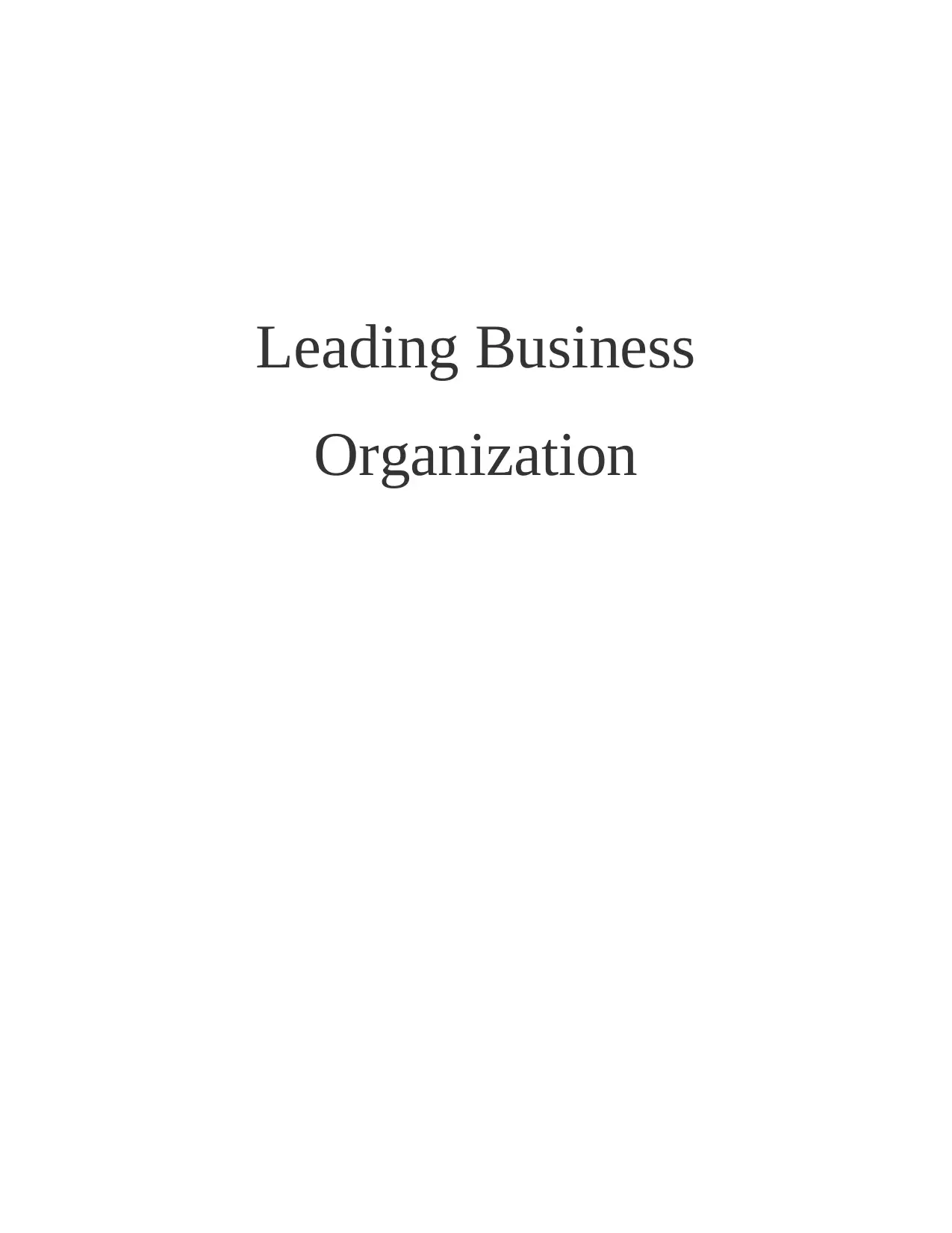
Leading Business
Organization
Organization
Secure Best Marks with AI Grader
Need help grading? Try our AI Grader for instant feedback on your assignments.
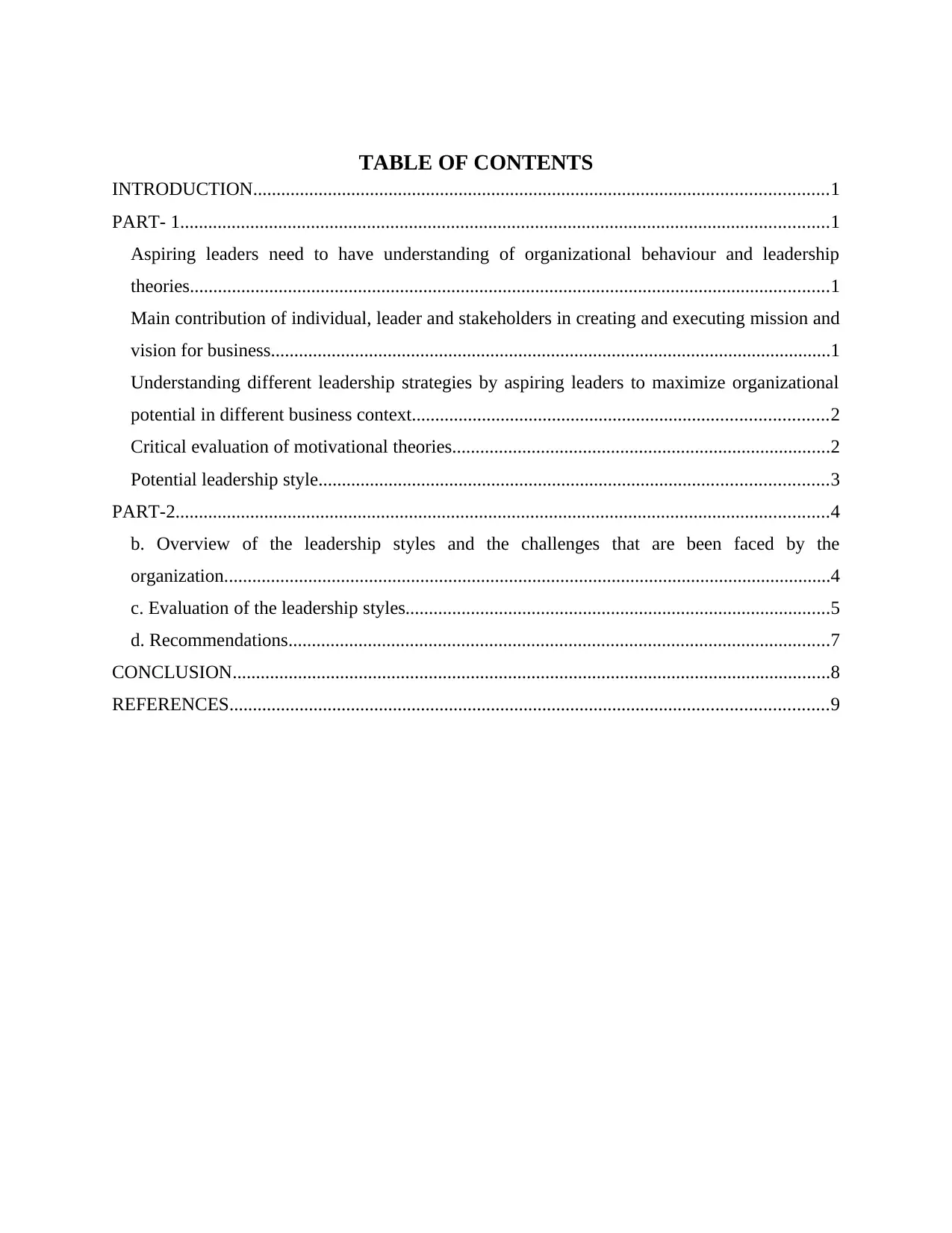
TABLE OF CONTENTS
INTRODUCTION...........................................................................................................................1
PART- 1...........................................................................................................................................1
Aspiring leaders need to have understanding of organizational behaviour and leadership
theories.........................................................................................................................................1
Main contribution of individual, leader and stakeholders in creating and executing mission and
vision for business........................................................................................................................1
Understanding different leadership strategies by aspiring leaders to maximize organizational
potential in different business context.........................................................................................2
Critical evaluation of motivational theories.................................................................................2
Potential leadership style.............................................................................................................3
PART-2............................................................................................................................................4
b. Overview of the leadership styles and the challenges that are been faced by the
organization..................................................................................................................................4
c. Evaluation of the leadership styles...........................................................................................5
d. Recommendations....................................................................................................................7
CONCLUSION................................................................................................................................8
REFERENCES................................................................................................................................9
INTRODUCTION...........................................................................................................................1
PART- 1...........................................................................................................................................1
Aspiring leaders need to have understanding of organizational behaviour and leadership
theories.........................................................................................................................................1
Main contribution of individual, leader and stakeholders in creating and executing mission and
vision for business........................................................................................................................1
Understanding different leadership strategies by aspiring leaders to maximize organizational
potential in different business context.........................................................................................2
Critical evaluation of motivational theories.................................................................................2
Potential leadership style.............................................................................................................3
PART-2............................................................................................................................................4
b. Overview of the leadership styles and the challenges that are been faced by the
organization..................................................................................................................................4
c. Evaluation of the leadership styles...........................................................................................5
d. Recommendations....................................................................................................................7
CONCLUSION................................................................................................................................8
REFERENCES................................................................................................................................9
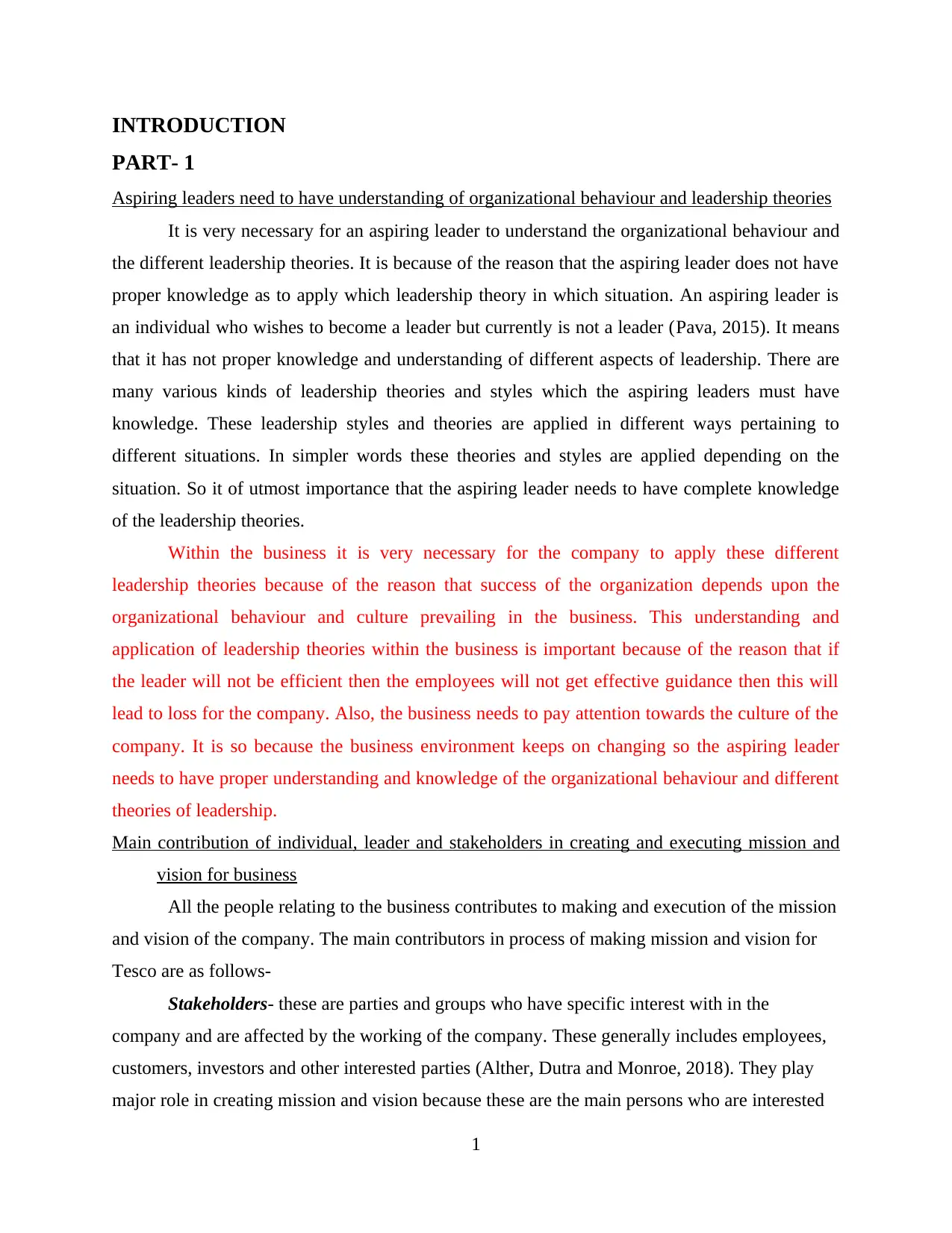
INTRODUCTION
PART- 1
Aspiring leaders need to have understanding of organizational behaviour and leadership theories
It is very necessary for an aspiring leader to understand the organizational behaviour and
the different leadership theories. It is because of the reason that the aspiring leader does not have
proper knowledge as to apply which leadership theory in which situation. An aspiring leader is
an individual who wishes to become a leader but currently is not a leader (Pava, 2015). It means
that it has not proper knowledge and understanding of different aspects of leadership. There are
many various kinds of leadership theories and styles which the aspiring leaders must have
knowledge. These leadership styles and theories are applied in different ways pertaining to
different situations. In simpler words these theories and styles are applied depending on the
situation. So it of utmost importance that the aspiring leader needs to have complete knowledge
of the leadership theories.
Within the business it is very necessary for the company to apply these different
leadership theories because of the reason that success of the organization depends upon the
organizational behaviour and culture prevailing in the business. This understanding and
application of leadership theories within the business is important because of the reason that if
the leader will not be efficient then the employees will not get effective guidance then this will
lead to loss for the company. Also, the business needs to pay attention towards the culture of the
company. It is so because the business environment keeps on changing so the aspiring leader
needs to have proper understanding and knowledge of the organizational behaviour and different
theories of leadership.
Main contribution of individual, leader and stakeholders in creating and executing mission and
vision for business
All the people relating to the business contributes to making and execution of the mission
and vision of the company. The main contributors in process of making mission and vision for
Tesco are as follows-
Stakeholders- these are parties and groups who have specific interest with in the
company and are affected by the working of the company. These generally includes employees,
customers, investors and other interested parties (Alther, Dutra and Monroe, 2018). They play
major role in creating mission and vision because these are the main persons who are interested
1
PART- 1
Aspiring leaders need to have understanding of organizational behaviour and leadership theories
It is very necessary for an aspiring leader to understand the organizational behaviour and
the different leadership theories. It is because of the reason that the aspiring leader does not have
proper knowledge as to apply which leadership theory in which situation. An aspiring leader is
an individual who wishes to become a leader but currently is not a leader (Pava, 2015). It means
that it has not proper knowledge and understanding of different aspects of leadership. There are
many various kinds of leadership theories and styles which the aspiring leaders must have
knowledge. These leadership styles and theories are applied in different ways pertaining to
different situations. In simpler words these theories and styles are applied depending on the
situation. So it of utmost importance that the aspiring leader needs to have complete knowledge
of the leadership theories.
Within the business it is very necessary for the company to apply these different
leadership theories because of the reason that success of the organization depends upon the
organizational behaviour and culture prevailing in the business. This understanding and
application of leadership theories within the business is important because of the reason that if
the leader will not be efficient then the employees will not get effective guidance then this will
lead to loss for the company. Also, the business needs to pay attention towards the culture of the
company. It is so because the business environment keeps on changing so the aspiring leader
needs to have proper understanding and knowledge of the organizational behaviour and different
theories of leadership.
Main contribution of individual, leader and stakeholders in creating and executing mission and
vision for business
All the people relating to the business contributes to making and execution of the mission
and vision of the company. The main contributors in process of making mission and vision for
Tesco are as follows-
Stakeholders- these are parties and groups who have specific interest with in the
company and are affected by the working of the company. These generally includes employees,
customers, investors and other interested parties (Alther, Dutra and Monroe, 2018). They play
major role in creating mission and vision because these are the main persons who are interested
1

in the profits earned by the company. So they try to develop such vision so that the company
earns maximum profits.
There are many different types of stakeholders like employees, consumers, shareholders,
government, suppliers and many other. All these different types of stakeholders help in executing
the mission and vision of the company. This is so because of the reason that like for instance,
employee’s intention is to get the salary and this they will get when they do work. and if they do
work then automatically the mission and vision of the company is achieved. In the similar way,
the motive of shareholder is to get the dividend on time. Therefore, this motive of the
shareholder helps the company in achieving its objective of profit earning. Thus, the different
stakeholders help in executing the mission and vision of the company.
Leaders- these are the main person behind the development of mission and vision. These
are the end results for whose accomplishment the company works and exist. They are the maker
of the vision and mission of the business, so they are the main contributors. They also ensure that
the vision and mission are achieved.
Individual- it can be any person relating to the business. For running the business every
individual has to establish some mission and vision so that the business runs in a set direction
which aims at achieving the mission and vision.
Understanding different leadership strategies by aspiring leaders to maximize organizational
potential in different business context
There are many types of leadership strategies which the person can employ within the
business for leading the business to success. The aspiring leader needs to have a great and in
depth understanding of applying these leadership styles into the business with the intention of
maximizing the profits and success for the business (Cullen and Murphy, 2018). The aspiring
leader wants to become a successful leader and for this it needs to develop a level of knowledge
and understanding of different leadership strategies and their application to different business
situations. This is because of the reason that these leadership strategies helps in solving particular
problems and situations which causes problem for the company. These leadership strategies
helps the aspiring leaders in maximizing organizational position of company as leadership helps
in solving the problem which may arise within the business. It is because of the reason that
business exist in dynamic environment so a single leadership strategy cannot apply to same
situation every time.
2
earns maximum profits.
There are many different types of stakeholders like employees, consumers, shareholders,
government, suppliers and many other. All these different types of stakeholders help in executing
the mission and vision of the company. This is so because of the reason that like for instance,
employee’s intention is to get the salary and this they will get when they do work. and if they do
work then automatically the mission and vision of the company is achieved. In the similar way,
the motive of shareholder is to get the dividend on time. Therefore, this motive of the
shareholder helps the company in achieving its objective of profit earning. Thus, the different
stakeholders help in executing the mission and vision of the company.
Leaders- these are the main person behind the development of mission and vision. These
are the end results for whose accomplishment the company works and exist. They are the maker
of the vision and mission of the business, so they are the main contributors. They also ensure that
the vision and mission are achieved.
Individual- it can be any person relating to the business. For running the business every
individual has to establish some mission and vision so that the business runs in a set direction
which aims at achieving the mission and vision.
Understanding different leadership strategies by aspiring leaders to maximize organizational
potential in different business context
There are many types of leadership strategies which the person can employ within the
business for leading the business to success. The aspiring leader needs to have a great and in
depth understanding of applying these leadership styles into the business with the intention of
maximizing the profits and success for the business (Cullen and Murphy, 2018). The aspiring
leader wants to become a successful leader and for this it needs to develop a level of knowledge
and understanding of different leadership strategies and their application to different business
situations. This is because of the reason that these leadership strategies helps in solving particular
problems and situations which causes problem for the company. These leadership strategies
helps the aspiring leaders in maximizing organizational position of company as leadership helps
in solving the problem which may arise within the business. It is because of the reason that
business exist in dynamic environment so a single leadership strategy cannot apply to same
situation every time.
2
Secure Best Marks with AI Grader
Need help grading? Try our AI Grader for instant feedback on your assignments.
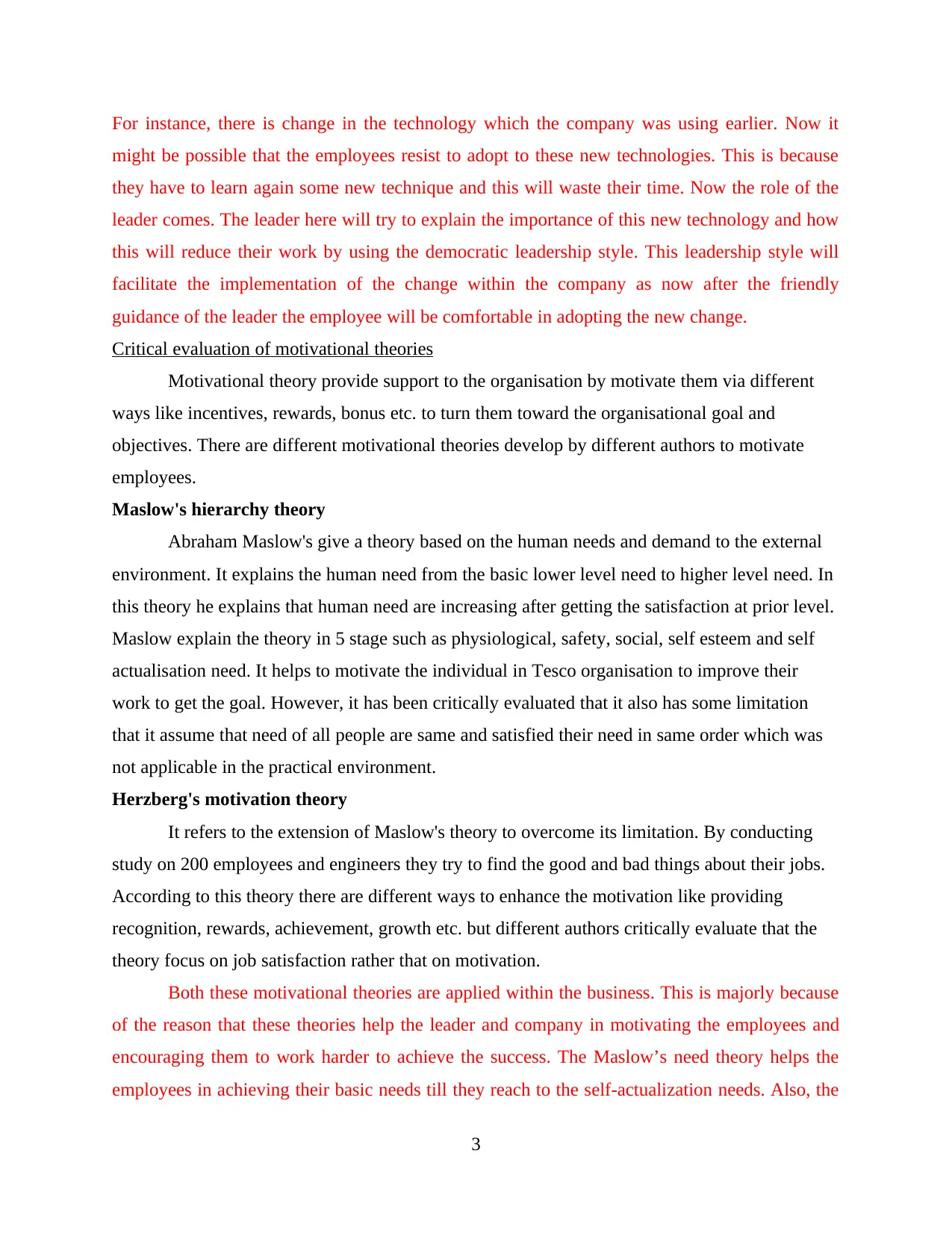
For instance, there is change in the technology which the company was using earlier. Now it
might be possible that the employees resist to adopt to these new technologies. This is because
they have to learn again some new technique and this will waste their time. Now the role of the
leader comes. The leader here will try to explain the importance of this new technology and how
this will reduce their work by using the democratic leadership style. This leadership style will
facilitate the implementation of the change within the company as now after the friendly
guidance of the leader the employee will be comfortable in adopting the new change.
Critical evaluation of motivational theories
Motivational theory provide support to the organisation by motivate them via different
ways like incentives, rewards, bonus etc. to turn them toward the organisational goal and
objectives. There are different motivational theories develop by different authors to motivate
employees.
Maslow's hierarchy theory
Abraham Maslow's give a theory based on the human needs and demand to the external
environment. It explains the human need from the basic lower level need to higher level need. In
this theory he explains that human need are increasing after getting the satisfaction at prior level.
Maslow explain the theory in 5 stage such as physiological, safety, social, self esteem and self
actualisation need. It helps to motivate the individual in Tesco organisation to improve their
work to get the goal. However, it has been critically evaluated that it also has some limitation
that it assume that need of all people are same and satisfied their need in same order which was
not applicable in the practical environment.
Herzberg's motivation theory
It refers to the extension of Maslow's theory to overcome its limitation. By conducting
study on 200 employees and engineers they try to find the good and bad things about their jobs.
According to this theory there are different ways to enhance the motivation like providing
recognition, rewards, achievement, growth etc. but different authors critically evaluate that the
theory focus on job satisfaction rather that on motivation.
Both these motivational theories are applied within the business. This is majorly because
of the reason that these theories help the leader and company in motivating the employees and
encouraging them to work harder to achieve the success. The Maslow’s need theory helps the
employees in achieving their basic needs till they reach to the self-actualization needs. Also, the
3
might be possible that the employees resist to adopt to these new technologies. This is because
they have to learn again some new technique and this will waste their time. Now the role of the
leader comes. The leader here will try to explain the importance of this new technology and how
this will reduce their work by using the democratic leadership style. This leadership style will
facilitate the implementation of the change within the company as now after the friendly
guidance of the leader the employee will be comfortable in adopting the new change.
Critical evaluation of motivational theories
Motivational theory provide support to the organisation by motivate them via different
ways like incentives, rewards, bonus etc. to turn them toward the organisational goal and
objectives. There are different motivational theories develop by different authors to motivate
employees.
Maslow's hierarchy theory
Abraham Maslow's give a theory based on the human needs and demand to the external
environment. It explains the human need from the basic lower level need to higher level need. In
this theory he explains that human need are increasing after getting the satisfaction at prior level.
Maslow explain the theory in 5 stage such as physiological, safety, social, self esteem and self
actualisation need. It helps to motivate the individual in Tesco organisation to improve their
work to get the goal. However, it has been critically evaluated that it also has some limitation
that it assume that need of all people are same and satisfied their need in same order which was
not applicable in the practical environment.
Herzberg's motivation theory
It refers to the extension of Maslow's theory to overcome its limitation. By conducting
study on 200 employees and engineers they try to find the good and bad things about their jobs.
According to this theory there are different ways to enhance the motivation like providing
recognition, rewards, achievement, growth etc. but different authors critically evaluate that the
theory focus on job satisfaction rather that on motivation.
Both these motivational theories are applied within the business. This is majorly because
of the reason that these theories help the leader and company in motivating the employees and
encouraging them to work harder to achieve the success. The Maslow’s need theory helps the
employees in achieving their basic needs till they reach to the self-actualization needs. Also, the
3
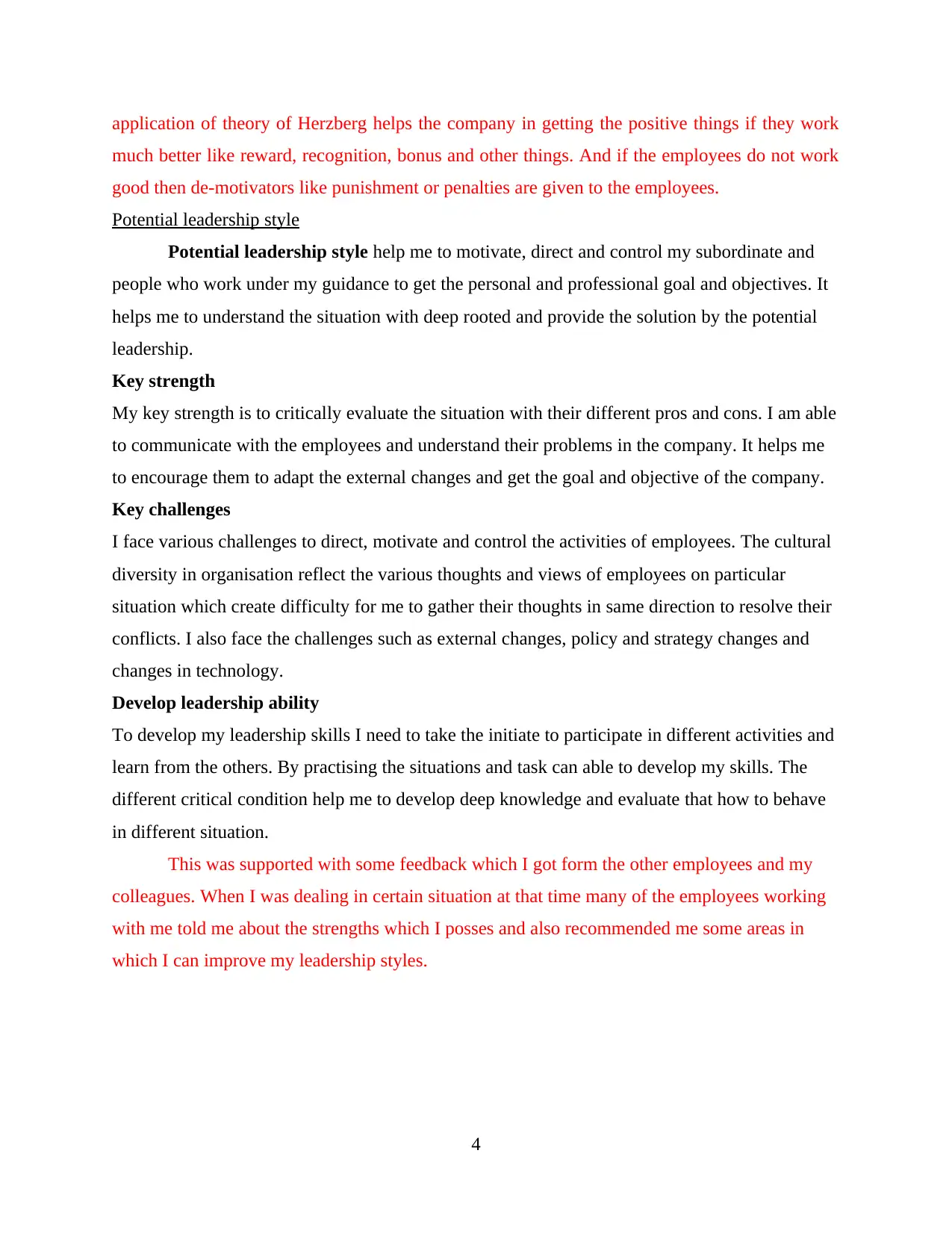
application of theory of Herzberg helps the company in getting the positive things if they work
much better like reward, recognition, bonus and other things. And if the employees do not work
good then de-motivators like punishment or penalties are given to the employees.
Potential leadership style
Potential leadership style help me to motivate, direct and control my subordinate and
people who work under my guidance to get the personal and professional goal and objectives. It
helps me to understand the situation with deep rooted and provide the solution by the potential
leadership.
Key strength
My key strength is to critically evaluate the situation with their different pros and cons. I am able
to communicate with the employees and understand their problems in the company. It helps me
to encourage them to adapt the external changes and get the goal and objective of the company.
Key challenges
I face various challenges to direct, motivate and control the activities of employees. The cultural
diversity in organisation reflect the various thoughts and views of employees on particular
situation which create difficulty for me to gather their thoughts in same direction to resolve their
conflicts. I also face the challenges such as external changes, policy and strategy changes and
changes in technology.
Develop leadership ability
To develop my leadership skills I need to take the initiate to participate in different activities and
learn from the others. By practising the situations and task can able to develop my skills. The
different critical condition help me to develop deep knowledge and evaluate that how to behave
in different situation.
This was supported with some feedback which I got form the other employees and my
colleagues. When I was dealing in certain situation at that time many of the employees working
with me told me about the strengths which I posses and also recommended me some areas in
which I can improve my leadership styles.
4
much better like reward, recognition, bonus and other things. And if the employees do not work
good then de-motivators like punishment or penalties are given to the employees.
Potential leadership style
Potential leadership style help me to motivate, direct and control my subordinate and
people who work under my guidance to get the personal and professional goal and objectives. It
helps me to understand the situation with deep rooted and provide the solution by the potential
leadership.
Key strength
My key strength is to critically evaluate the situation with their different pros and cons. I am able
to communicate with the employees and understand their problems in the company. It helps me
to encourage them to adapt the external changes and get the goal and objective of the company.
Key challenges
I face various challenges to direct, motivate and control the activities of employees. The cultural
diversity in organisation reflect the various thoughts and views of employees on particular
situation which create difficulty for me to gather their thoughts in same direction to resolve their
conflicts. I also face the challenges such as external changes, policy and strategy changes and
changes in technology.
Develop leadership ability
To develop my leadership skills I need to take the initiate to participate in different activities and
learn from the others. By practising the situations and task can able to develop my skills. The
different critical condition help me to develop deep knowledge and evaluate that how to behave
in different situation.
This was supported with some feedback which I got form the other employees and my
colleagues. When I was dealing in certain situation at that time many of the employees working
with me told me about the strengths which I posses and also recommended me some areas in
which I can improve my leadership styles.
4
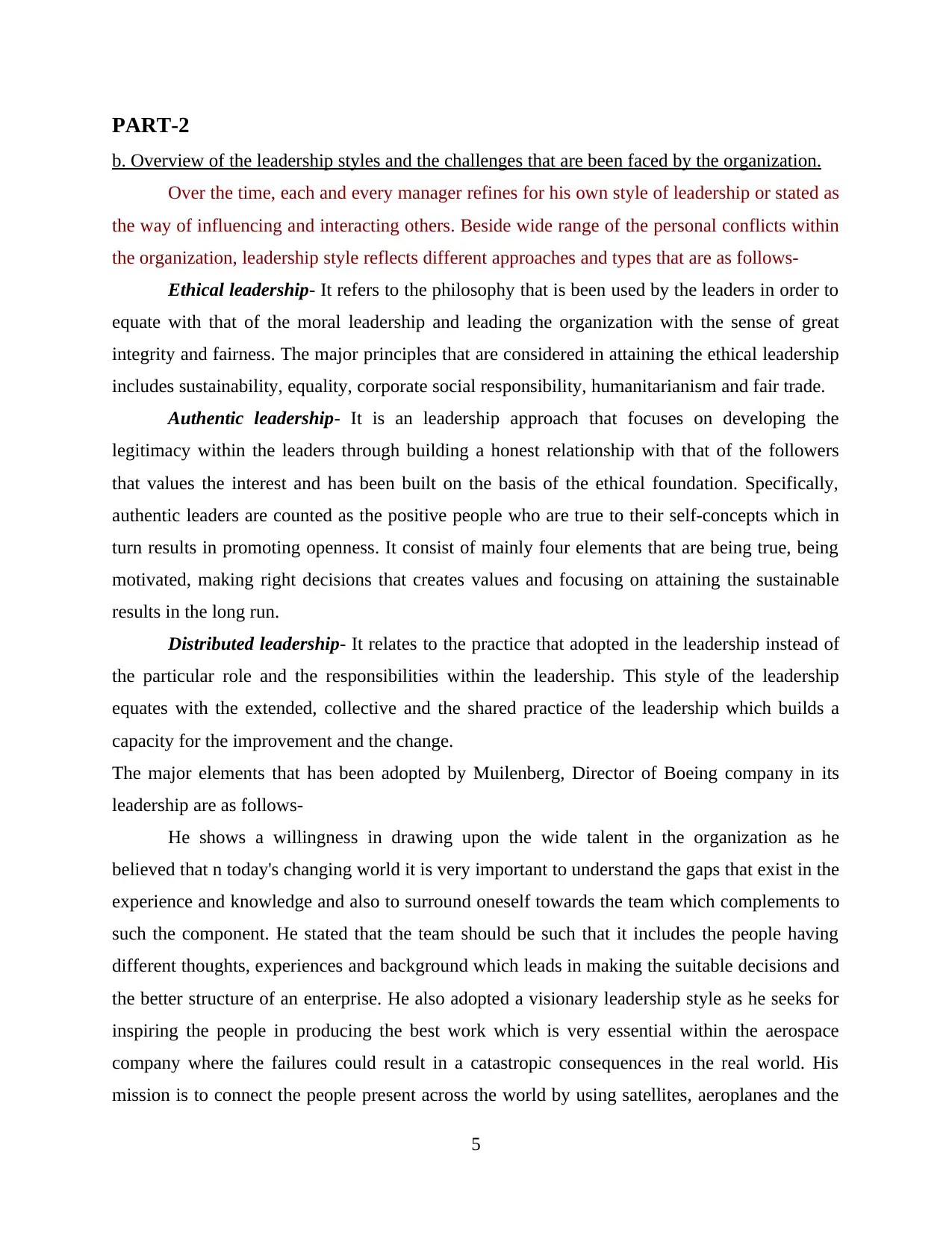
PART-2
b. Overview of the leadership styles and the challenges that are been faced by the organization.
Over the time, each and every manager refines for his own style of leadership or stated as
the way of influencing and interacting others. Beside wide range of the personal conflicts within
the organization, leadership style reflects different approaches and types that are as follows-
Ethical leadership- It refers to the philosophy that is been used by the leaders in order to
equate with that of the moral leadership and leading the organization with the sense of great
integrity and fairness. The major principles that are considered in attaining the ethical leadership
includes sustainability, equality, corporate social responsibility, humanitarianism and fair trade.
Authentic leadership- It is an leadership approach that focuses on developing the
legitimacy within the leaders through building a honest relationship with that of the followers
that values the interest and has been built on the basis of the ethical foundation. Specifically,
authentic leaders are counted as the positive people who are true to their self-concepts which in
turn results in promoting openness. It consist of mainly four elements that are being true, being
motivated, making right decisions that creates values and focusing on attaining the sustainable
results in the long run.
Distributed leadership- It relates to the practice that adopted in the leadership instead of
the particular role and the responsibilities within the leadership. This style of the leadership
equates with the extended, collective and the shared practice of the leadership which builds a
capacity for the improvement and the change.
The major elements that has been adopted by Muilenberg, Director of Boeing company in its
leadership are as follows-
He shows a willingness in drawing upon the wide talent in the organization as he
believed that n today's changing world it is very important to understand the gaps that exist in the
experience and knowledge and also to surround oneself towards the team which complements to
such the component. He stated that the team should be such that it includes the people having
different thoughts, experiences and background which leads in making the suitable decisions and
the better structure of an enterprise. He also adopted a visionary leadership style as he seeks for
inspiring the people in producing the best work which is very essential within the aerospace
company where the failures could result in a catastropic consequences in the real world. His
mission is to connect the people present across the world by using satellites, aeroplanes and the
5
b. Overview of the leadership styles and the challenges that are been faced by the organization.
Over the time, each and every manager refines for his own style of leadership or stated as
the way of influencing and interacting others. Beside wide range of the personal conflicts within
the organization, leadership style reflects different approaches and types that are as follows-
Ethical leadership- It refers to the philosophy that is been used by the leaders in order to
equate with that of the moral leadership and leading the organization with the sense of great
integrity and fairness. The major principles that are considered in attaining the ethical leadership
includes sustainability, equality, corporate social responsibility, humanitarianism and fair trade.
Authentic leadership- It is an leadership approach that focuses on developing the
legitimacy within the leaders through building a honest relationship with that of the followers
that values the interest and has been built on the basis of the ethical foundation. Specifically,
authentic leaders are counted as the positive people who are true to their self-concepts which in
turn results in promoting openness. It consist of mainly four elements that are being true, being
motivated, making right decisions that creates values and focusing on attaining the sustainable
results in the long run.
Distributed leadership- It relates to the practice that adopted in the leadership instead of
the particular role and the responsibilities within the leadership. This style of the leadership
equates with the extended, collective and the shared practice of the leadership which builds a
capacity for the improvement and the change.
The major elements that has been adopted by Muilenberg, Director of Boeing company in its
leadership are as follows-
He shows a willingness in drawing upon the wide talent in the organization as he
believed that n today's changing world it is very important to understand the gaps that exist in the
experience and knowledge and also to surround oneself towards the team which complements to
such the component. He stated that the team should be such that it includes the people having
different thoughts, experiences and background which leads in making the suitable decisions and
the better structure of an enterprise. He also adopted a visionary leadership style as he seeks for
inspiring the people in producing the best work which is very essential within the aerospace
company where the failures could result in a catastropic consequences in the real world. His
mission is to connect the people present across the world by using satellites, aeroplanes and the
5
Paraphrase This Document
Need a fresh take? Get an instant paraphrase of this document with our AI Paraphraser
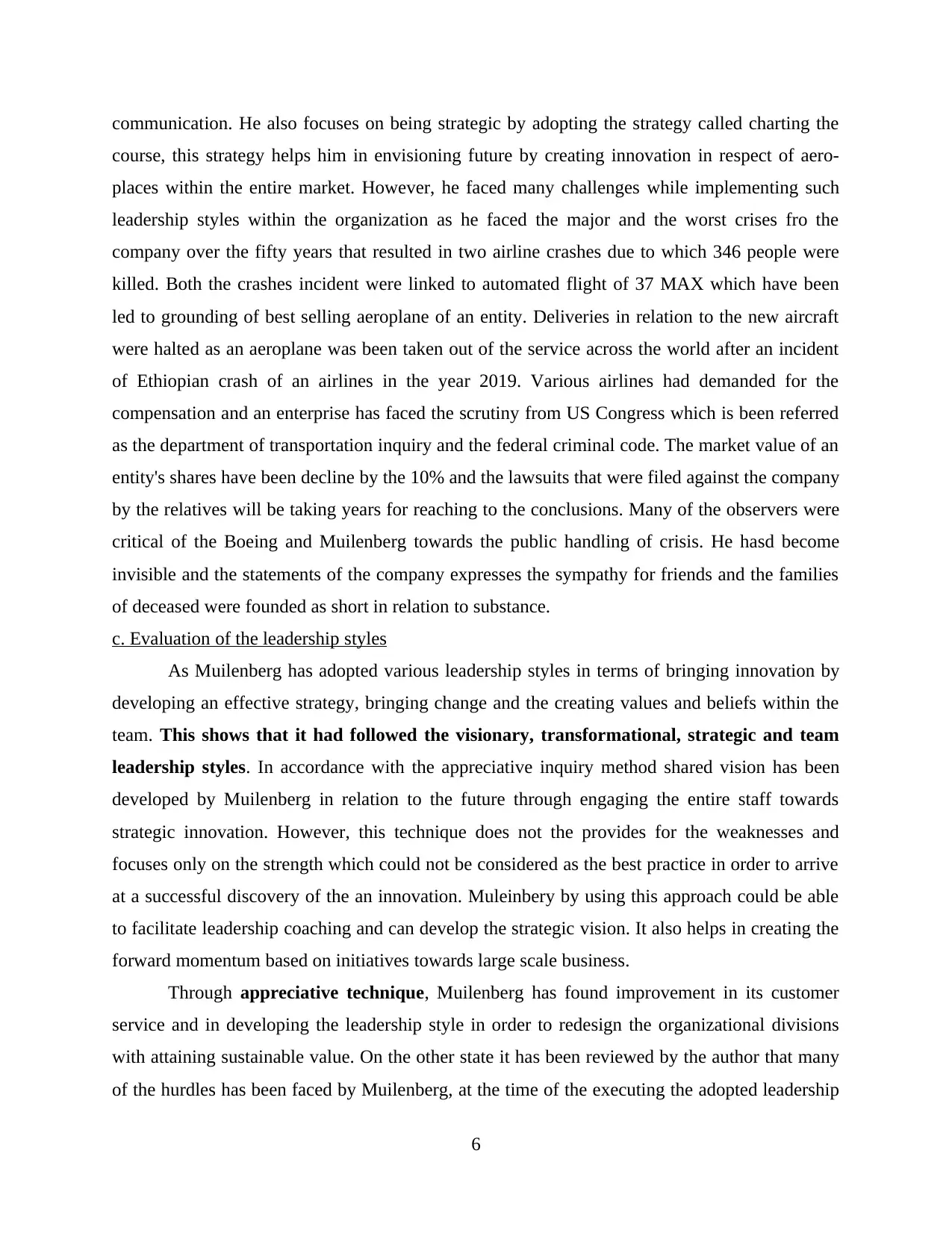
communication. He also focuses on being strategic by adopting the strategy called charting the
course, this strategy helps him in envisioning future by creating innovation in respect of aero-
places within the entire market. However, he faced many challenges while implementing such
leadership styles within the organization as he faced the major and the worst crises fro the
company over the fifty years that resulted in two airline crashes due to which 346 people were
killed. Both the crashes incident were linked to automated flight of 37 MAX which have been
led to grounding of best selling aeroplane of an entity. Deliveries in relation to the new aircraft
were halted as an aeroplane was been taken out of the service across the world after an incident
of Ethiopian crash of an airlines in the year 2019. Various airlines had demanded for the
compensation and an enterprise has faced the scrutiny from US Congress which is been referred
as the department of transportation inquiry and the federal criminal code. The market value of an
entity's shares have been decline by the 10% and the lawsuits that were filed against the company
by the relatives will be taking years for reaching to the conclusions. Many of the observers were
critical of the Boeing and Muilenberg towards the public handling of crisis. He hasd become
invisible and the statements of the company expresses the sympathy for friends and the families
of deceased were founded as short in relation to substance.
c. Evaluation of the leadership styles
As Muilenberg has adopted various leadership styles in terms of bringing innovation by
developing an effective strategy, bringing change and the creating values and beliefs within the
team. This shows that it had followed the visionary, transformational, strategic and team
leadership styles. In accordance with the appreciative inquiry method shared vision has been
developed by Muilenberg in relation to the future through engaging the entire staff towards
strategic innovation. However, this technique does not the provides for the weaknesses and
focuses only on the strength which could not be considered as the best practice in order to arrive
at a successful discovery of the an innovation. Muleinbery by using this approach could be able
to facilitate leadership coaching and can develop the strategic vision. It also helps in creating the
forward momentum based on initiatives towards large scale business.
Through appreciative technique, Muilenberg has found improvement in its customer
service and in developing the leadership style in order to redesign the organizational divisions
with attaining sustainable value. On the other state it has been reviewed by the author that many
of the hurdles has been faced by Muilenberg, at the time of the executing the adopted leadership
6
course, this strategy helps him in envisioning future by creating innovation in respect of aero-
places within the entire market. However, he faced many challenges while implementing such
leadership styles within the organization as he faced the major and the worst crises fro the
company over the fifty years that resulted in two airline crashes due to which 346 people were
killed. Both the crashes incident were linked to automated flight of 37 MAX which have been
led to grounding of best selling aeroplane of an entity. Deliveries in relation to the new aircraft
were halted as an aeroplane was been taken out of the service across the world after an incident
of Ethiopian crash of an airlines in the year 2019. Various airlines had demanded for the
compensation and an enterprise has faced the scrutiny from US Congress which is been referred
as the department of transportation inquiry and the federal criminal code. The market value of an
entity's shares have been decline by the 10% and the lawsuits that were filed against the company
by the relatives will be taking years for reaching to the conclusions. Many of the observers were
critical of the Boeing and Muilenberg towards the public handling of crisis. He hasd become
invisible and the statements of the company expresses the sympathy for friends and the families
of deceased were founded as short in relation to substance.
c. Evaluation of the leadership styles
As Muilenberg has adopted various leadership styles in terms of bringing innovation by
developing an effective strategy, bringing change and the creating values and beliefs within the
team. This shows that it had followed the visionary, transformational, strategic and team
leadership styles. In accordance with the appreciative inquiry method shared vision has been
developed by Muilenberg in relation to the future through engaging the entire staff towards
strategic innovation. However, this technique does not the provides for the weaknesses and
focuses only on the strength which could not be considered as the best practice in order to arrive
at a successful discovery of the an innovation. Muleinbery by using this approach could be able
to facilitate leadership coaching and can develop the strategic vision. It also helps in creating the
forward momentum based on initiatives towards large scale business.
Through appreciative technique, Muilenberg has found improvement in its customer
service and in developing the leadership style in order to redesign the organizational divisions
with attaining sustainable value. On the other state it has been reviewed by the author that many
of the hurdles has been faced by Muilenberg, at the time of the executing the adopted leadership
6
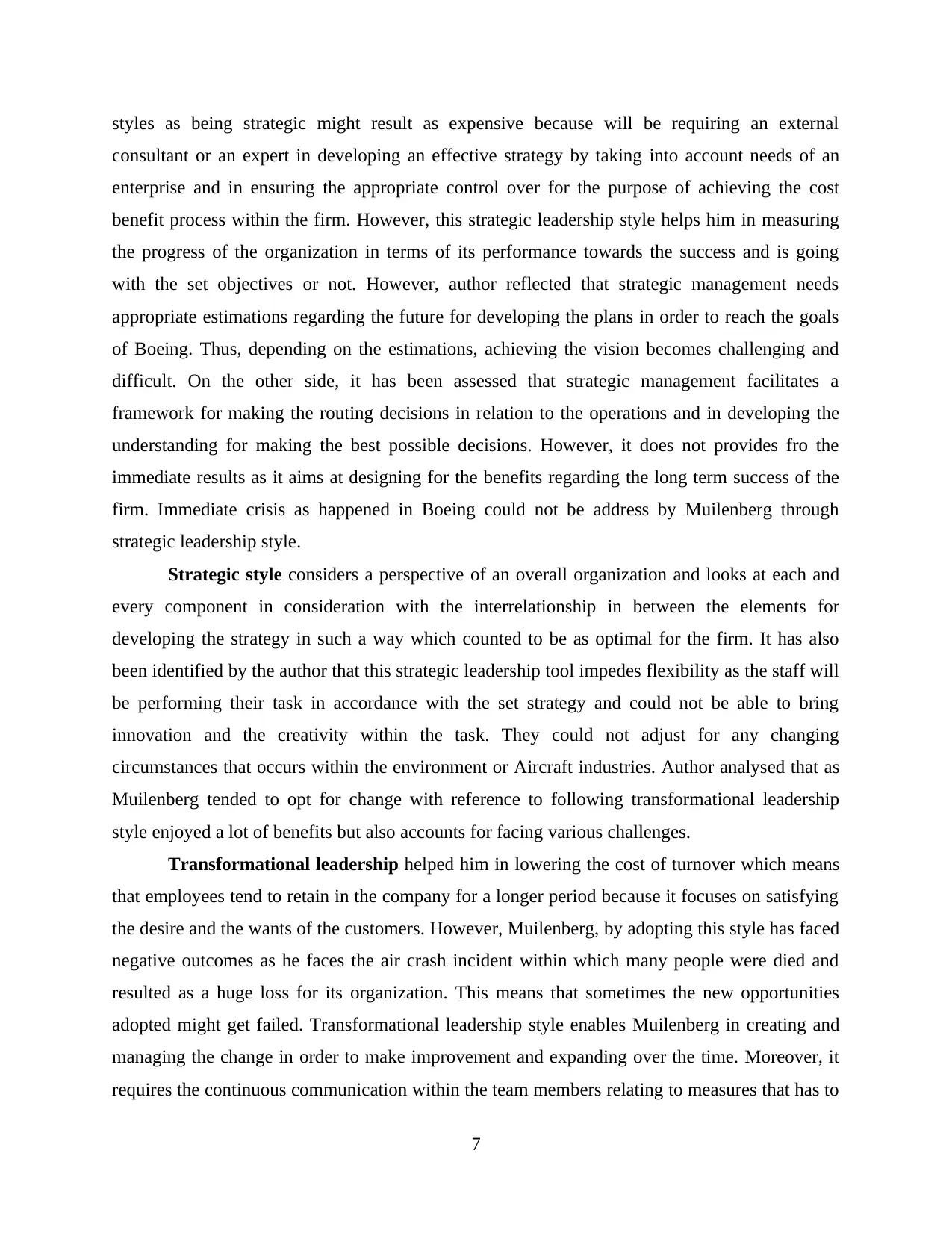
styles as being strategic might result as expensive because will be requiring an external
consultant or an expert in developing an effective strategy by taking into account needs of an
enterprise and in ensuring the appropriate control over for the purpose of achieving the cost
benefit process within the firm. However, this strategic leadership style helps him in measuring
the progress of the organization in terms of its performance towards the success and is going
with the set objectives or not. However, author reflected that strategic management needs
appropriate estimations regarding the future for developing the plans in order to reach the goals
of Boeing. Thus, depending on the estimations, achieving the vision becomes challenging and
difficult. On the other side, it has been assessed that strategic management facilitates a
framework for making the routing decisions in relation to the operations and in developing the
understanding for making the best possible decisions. However, it does not provides fro the
immediate results as it aims at designing for the benefits regarding the long term success of the
firm. Immediate crisis as happened in Boeing could not be address by Muilenberg through
strategic leadership style.
Strategic style considers a perspective of an overall organization and looks at each and
every component in consideration with the interrelationship in between the elements for
developing the strategy in such a way which counted to be as optimal for the firm. It has also
been identified by the author that this strategic leadership tool impedes flexibility as the staff will
be performing their task in accordance with the set strategy and could not be able to bring
innovation and the creativity within the task. They could not adjust for any changing
circumstances that occurs within the environment or Aircraft industries. Author analysed that as
Muilenberg tended to opt for change with reference to following transformational leadership
style enjoyed a lot of benefits but also accounts for facing various challenges.
Transformational leadership helped him in lowering the cost of turnover which means
that employees tend to retain in the company for a longer period because it focuses on satisfying
the desire and the wants of the customers. However, Muilenberg, by adopting this style has faced
negative outcomes as he faces the air crash incident within which many people were died and
resulted as a huge loss for its organization. This means that sometimes the new opportunities
adopted might get failed. Transformational leadership style enables Muilenberg in creating and
managing the change in order to make improvement and expanding over the time. Moreover, it
requires the continuous communication within the team members relating to measures that has to
7
consultant or an expert in developing an effective strategy by taking into account needs of an
enterprise and in ensuring the appropriate control over for the purpose of achieving the cost
benefit process within the firm. However, this strategic leadership style helps him in measuring
the progress of the organization in terms of its performance towards the success and is going
with the set objectives or not. However, author reflected that strategic management needs
appropriate estimations regarding the future for developing the plans in order to reach the goals
of Boeing. Thus, depending on the estimations, achieving the vision becomes challenging and
difficult. On the other side, it has been assessed that strategic management facilitates a
framework for making the routing decisions in relation to the operations and in developing the
understanding for making the best possible decisions. However, it does not provides fro the
immediate results as it aims at designing for the benefits regarding the long term success of the
firm. Immediate crisis as happened in Boeing could not be address by Muilenberg through
strategic leadership style.
Strategic style considers a perspective of an overall organization and looks at each and
every component in consideration with the interrelationship in between the elements for
developing the strategy in such a way which counted to be as optimal for the firm. It has also
been identified by the author that this strategic leadership tool impedes flexibility as the staff will
be performing their task in accordance with the set strategy and could not be able to bring
innovation and the creativity within the task. They could not adjust for any changing
circumstances that occurs within the environment or Aircraft industries. Author analysed that as
Muilenberg tended to opt for change with reference to following transformational leadership
style enjoyed a lot of benefits but also accounts for facing various challenges.
Transformational leadership helped him in lowering the cost of turnover which means
that employees tend to retain in the company for a longer period because it focuses on satisfying
the desire and the wants of the customers. However, Muilenberg, by adopting this style has faced
negative outcomes as he faces the air crash incident within which many people were died and
resulted as a huge loss for its organization. This means that sometimes the new opportunities
adopted might get failed. Transformational leadership style enables Muilenberg in creating and
managing the change in order to make improvement and expanding over the time. Moreover, it
requires the continuous communication within the team members relating to measures that has to
7
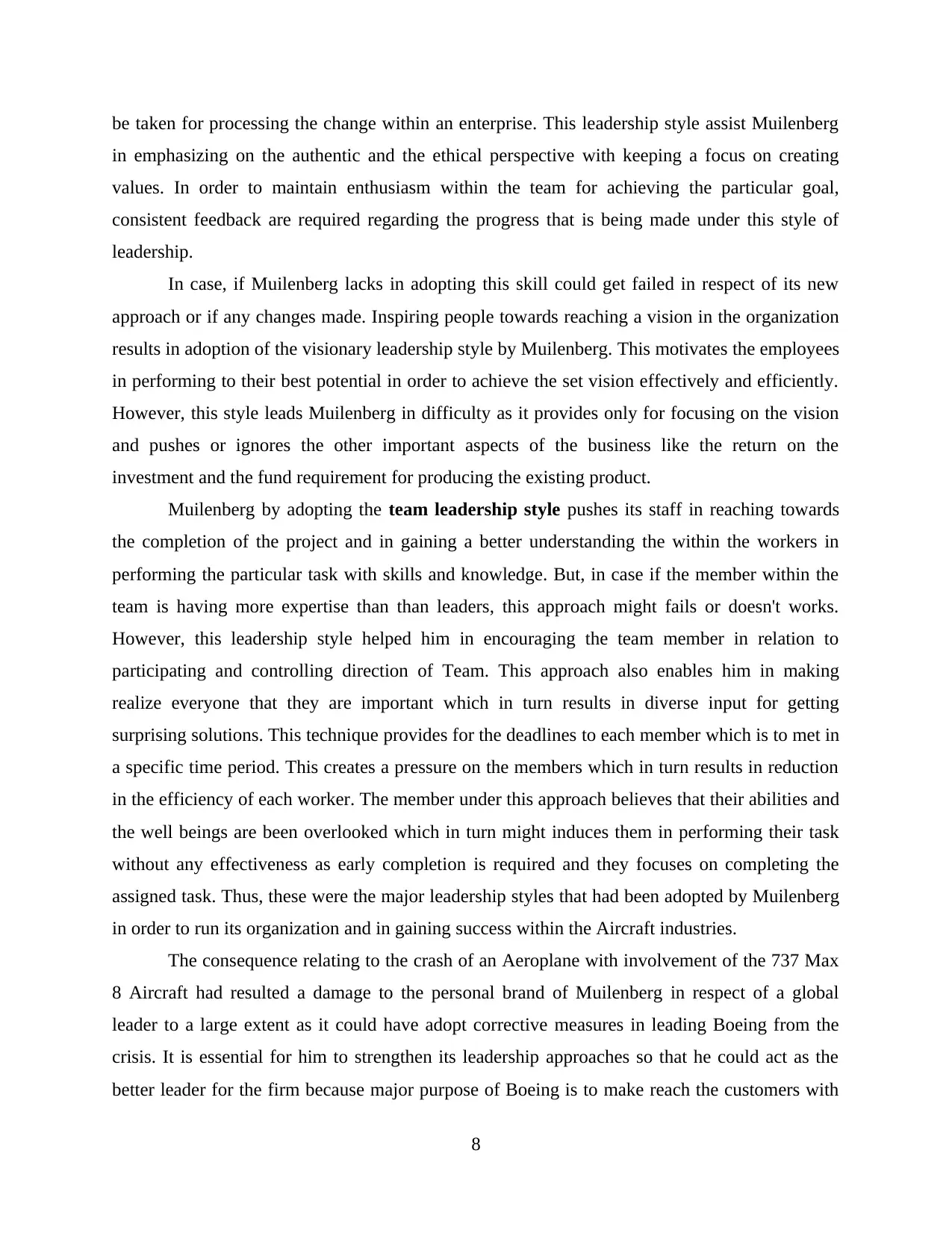
be taken for processing the change within an enterprise. This leadership style assist Muilenberg
in emphasizing on the authentic and the ethical perspective with keeping a focus on creating
values. In order to maintain enthusiasm within the team for achieving the particular goal,
consistent feedback are required regarding the progress that is being made under this style of
leadership.
In case, if Muilenberg lacks in adopting this skill could get failed in respect of its new
approach or if any changes made. Inspiring people towards reaching a vision in the organization
results in adoption of the visionary leadership style by Muilenberg. This motivates the employees
in performing to their best potential in order to achieve the set vision effectively and efficiently.
However, this style leads Muilenberg in difficulty as it provides only for focusing on the vision
and pushes or ignores the other important aspects of the business like the return on the
investment and the fund requirement for producing the existing product.
Muilenberg by adopting the team leadership style pushes its staff in reaching towards
the completion of the project and in gaining a better understanding the within the workers in
performing the particular task with skills and knowledge. But, in case if the member within the
team is having more expertise than than leaders, this approach might fails or doesn't works.
However, this leadership style helped him in encouraging the team member in relation to
participating and controlling direction of Team. This approach also enables him in making
realize everyone that they are important which in turn results in diverse input for getting
surprising solutions. This technique provides for the deadlines to each member which is to met in
a specific time period. This creates a pressure on the members which in turn results in reduction
in the efficiency of each worker. The member under this approach believes that their abilities and
the well beings are been overlooked which in turn might induces them in performing their task
without any effectiveness as early completion is required and they focuses on completing the
assigned task. Thus, these were the major leadership styles that had been adopted by Muilenberg
in order to run its organization and in gaining success within the Aircraft industries.
The consequence relating to the crash of an Aeroplane with involvement of the 737 Max
8 Aircraft had resulted a damage to the personal brand of Muilenberg in respect of a global
leader to a large extent as it could have adopt corrective measures in leading Boeing from the
crisis. It is essential for him to strengthen its leadership approaches so that he could act as the
better leader for the firm because major purpose of Boeing is to make reach the customers with
8
in emphasizing on the authentic and the ethical perspective with keeping a focus on creating
values. In order to maintain enthusiasm within the team for achieving the particular goal,
consistent feedback are required regarding the progress that is being made under this style of
leadership.
In case, if Muilenberg lacks in adopting this skill could get failed in respect of its new
approach or if any changes made. Inspiring people towards reaching a vision in the organization
results in adoption of the visionary leadership style by Muilenberg. This motivates the employees
in performing to their best potential in order to achieve the set vision effectively and efficiently.
However, this style leads Muilenberg in difficulty as it provides only for focusing on the vision
and pushes or ignores the other important aspects of the business like the return on the
investment and the fund requirement for producing the existing product.
Muilenberg by adopting the team leadership style pushes its staff in reaching towards
the completion of the project and in gaining a better understanding the within the workers in
performing the particular task with skills and knowledge. But, in case if the member within the
team is having more expertise than than leaders, this approach might fails or doesn't works.
However, this leadership style helped him in encouraging the team member in relation to
participating and controlling direction of Team. This approach also enables him in making
realize everyone that they are important which in turn results in diverse input for getting
surprising solutions. This technique provides for the deadlines to each member which is to met in
a specific time period. This creates a pressure on the members which in turn results in reduction
in the efficiency of each worker. The member under this approach believes that their abilities and
the well beings are been overlooked which in turn might induces them in performing their task
without any effectiveness as early completion is required and they focuses on completing the
assigned task. Thus, these were the major leadership styles that had been adopted by Muilenberg
in order to run its organization and in gaining success within the Aircraft industries.
The consequence relating to the crash of an Aeroplane with involvement of the 737 Max
8 Aircraft had resulted a damage to the personal brand of Muilenberg in respect of a global
leader to a large extent as it could have adopt corrective measures in leading Boeing from the
crisis. It is essential for him to strengthen its leadership approaches so that he could act as the
better leader for the firm because major purpose of Boeing is to make reach the customers with
8
Secure Best Marks with AI Grader
Need help grading? Try our AI Grader for instant feedback on your assignments.
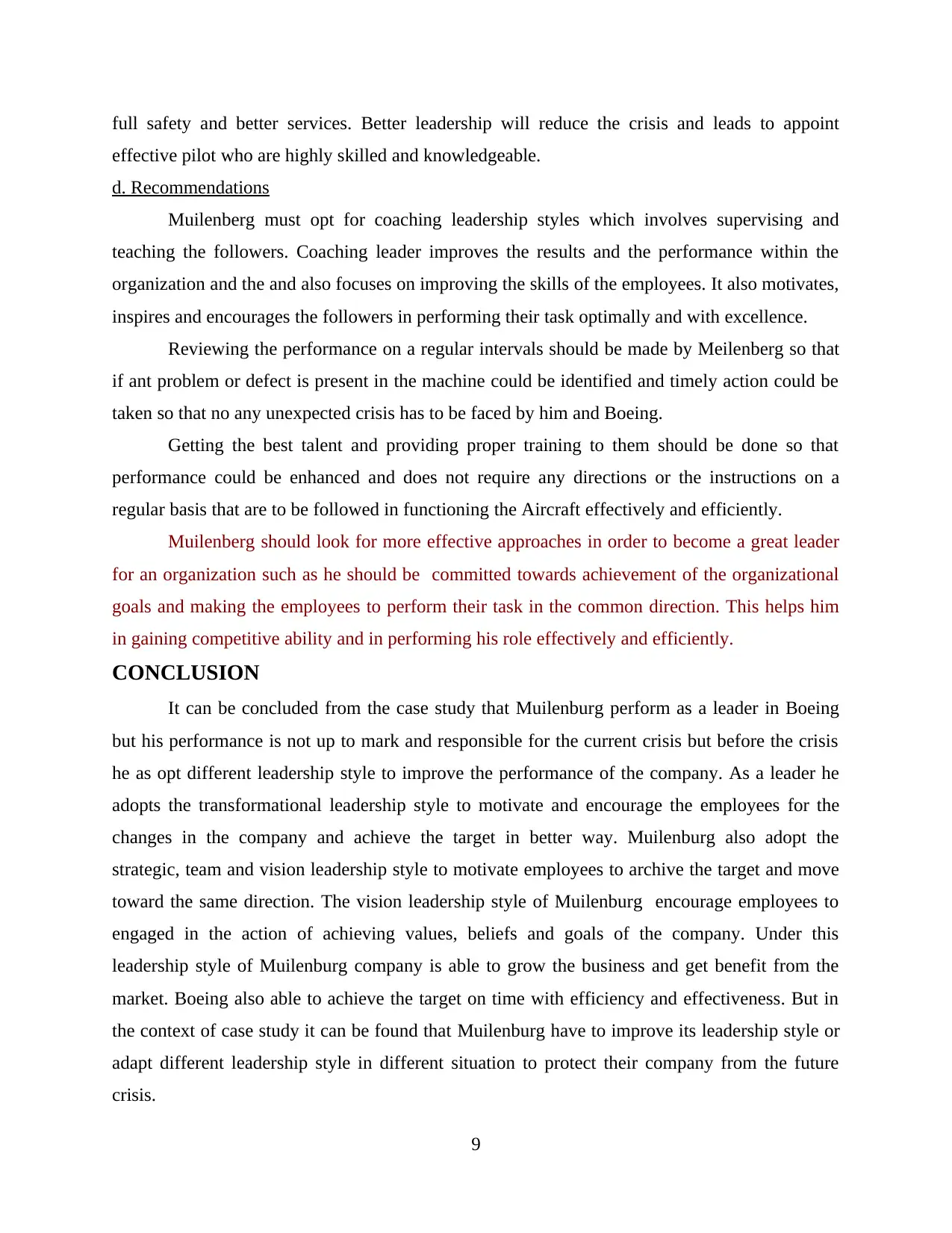
full safety and better services. Better leadership will reduce the crisis and leads to appoint
effective pilot who are highly skilled and knowledgeable.
d. Recommendations
Muilenberg must opt for coaching leadership styles which involves supervising and
teaching the followers. Coaching leader improves the results and the performance within the
organization and the and also focuses on improving the skills of the employees. It also motivates,
inspires and encourages the followers in performing their task optimally and with excellence.
Reviewing the performance on a regular intervals should be made by Meilenberg so that
if ant problem or defect is present in the machine could be identified and timely action could be
taken so that no any unexpected crisis has to be faced by him and Boeing.
Getting the best talent and providing proper training to them should be done so that
performance could be enhanced and does not require any directions or the instructions on a
regular basis that are to be followed in functioning the Aircraft effectively and efficiently.
Muilenberg should look for more effective approaches in order to become a great leader
for an organization such as he should be committed towards achievement of the organizational
goals and making the employees to perform their task in the common direction. This helps him
in gaining competitive ability and in performing his role effectively and efficiently.
CONCLUSION
It can be concluded from the case study that Muilenburg perform as a leader in Boeing
but his performance is not up to mark and responsible for the current crisis but before the crisis
he as opt different leadership style to improve the performance of the company. As a leader he
adopts the transformational leadership style to motivate and encourage the employees for the
changes in the company and achieve the target in better way. Muilenburg also adopt the
strategic, team and vision leadership style to motivate employees to archive the target and move
toward the same direction. The vision leadership style of Muilenburg encourage employees to
engaged in the action of achieving values, beliefs and goals of the company. Under this
leadership style of Muilenburg company is able to grow the business and get benefit from the
market. Boeing also able to achieve the target on time with efficiency and effectiveness. But in
the context of case study it can be found that Muilenburg have to improve its leadership style or
adapt different leadership style in different situation to protect their company from the future
crisis.
9
effective pilot who are highly skilled and knowledgeable.
d. Recommendations
Muilenberg must opt for coaching leadership styles which involves supervising and
teaching the followers. Coaching leader improves the results and the performance within the
organization and the and also focuses on improving the skills of the employees. It also motivates,
inspires and encourages the followers in performing their task optimally and with excellence.
Reviewing the performance on a regular intervals should be made by Meilenberg so that
if ant problem or defect is present in the machine could be identified and timely action could be
taken so that no any unexpected crisis has to be faced by him and Boeing.
Getting the best talent and providing proper training to them should be done so that
performance could be enhanced and does not require any directions or the instructions on a
regular basis that are to be followed in functioning the Aircraft effectively and efficiently.
Muilenberg should look for more effective approaches in order to become a great leader
for an organization such as he should be committed towards achievement of the organizational
goals and making the employees to perform their task in the common direction. This helps him
in gaining competitive ability and in performing his role effectively and efficiently.
CONCLUSION
It can be concluded from the case study that Muilenburg perform as a leader in Boeing
but his performance is not up to mark and responsible for the current crisis but before the crisis
he as opt different leadership style to improve the performance of the company. As a leader he
adopts the transformational leadership style to motivate and encourage the employees for the
changes in the company and achieve the target in better way. Muilenburg also adopt the
strategic, team and vision leadership style to motivate employees to archive the target and move
toward the same direction. The vision leadership style of Muilenburg encourage employees to
engaged in the action of achieving values, beliefs and goals of the company. Under this
leadership style of Muilenburg company is able to grow the business and get benefit from the
market. Boeing also able to achieve the target on time with efficiency and effectiveness. But in
the context of case study it can be found that Muilenburg have to improve its leadership style or
adapt different leadership style in different situation to protect their company from the future
crisis.
9

REFERENCES
Books and Journals
Alther, G., Dutra, N. and Monroe, C., 2018. Challenges of leading a small development
organization in odisha, India, that seeks to empower women through enterprise activities.
SAGE Publications: SAGE Business Cases Originals.
Amanchukwu, R. N., Stanley, G. J. and Ololube, N. P., 2015. A review of leadership theories,
principles and styles and their relevance to educational management. Management, 5(1),
pp.6-14.
Anderson, M. H. and Sun, P. Y., 2017. Reviewing leadership styles: Overlaps and the need for a
new ‘full‐range’theory. International Journal of Management Reviews. 19(1). pp.76-96.
Arnold, K. A. and et.al., 2015. Leadership styles, emotion regulation, and burnout. Journal of
Occupational Health Psychology. 20(4). p.481.
Choi, S. B., Kim, K. and Kang, S. W., 2017. Effects of transformational and shared leadership
styles on employees' perception of team effectiveness. Social Behavior and Personality: an
international journal. 45(3). pp.377-386.
Cullen, P. and Murphy, M.P., 2018. Leading the debate for the business case for gender equality,
perilous for whom?. Gender, Work & Organization. 25(2). pp.110-126.
Demirçelik, E. and Korkmaz, M., 2017. The relationship between the leadership styles of school
managers and organizational cynicism according to the perceptions of secondary school
teachers. International Journal of Society Researches. 7(12). pp.33-53.
Frankel, A. and PGCMS, R., 2019. What leadership styles should senior nurses
develop?. Hospital. 6. p.08.
Healy, K., 2016. A Theory of Human Motivation by Abraham H. Maslow (1942). The British
Journal of Psychiatry, 208(4). pp.313-313.
Hu, Y.Y. and et.al., 2016. Surgeons' leadership styles and team behavior in the operating
room. Journal of the American College of Surgeons. 222(1). pp.41-51.
Kang, J. H., Solomon, G. T. and Choi, D. Y., 2015. CEOs' leadership styles and managers'
innovative behaviour: Investigation of intervening effects in an entrepreneurial
context. Journal of Management Studies. 52(4). pp.531-554.
10
Books and Journals
Alther, G., Dutra, N. and Monroe, C., 2018. Challenges of leading a small development
organization in odisha, India, that seeks to empower women through enterprise activities.
SAGE Publications: SAGE Business Cases Originals.
Amanchukwu, R. N., Stanley, G. J. and Ololube, N. P., 2015. A review of leadership theories,
principles and styles and their relevance to educational management. Management, 5(1),
pp.6-14.
Anderson, M. H. and Sun, P. Y., 2017. Reviewing leadership styles: Overlaps and the need for a
new ‘full‐range’theory. International Journal of Management Reviews. 19(1). pp.76-96.
Arnold, K. A. and et.al., 2015. Leadership styles, emotion regulation, and burnout. Journal of
Occupational Health Psychology. 20(4). p.481.
Choi, S. B., Kim, K. and Kang, S. W., 2017. Effects of transformational and shared leadership
styles on employees' perception of team effectiveness. Social Behavior and Personality: an
international journal. 45(3). pp.377-386.
Cullen, P. and Murphy, M.P., 2018. Leading the debate for the business case for gender equality,
perilous for whom?. Gender, Work & Organization. 25(2). pp.110-126.
Demirçelik, E. and Korkmaz, M., 2017. The relationship between the leadership styles of school
managers and organizational cynicism according to the perceptions of secondary school
teachers. International Journal of Society Researches. 7(12). pp.33-53.
Frankel, A. and PGCMS, R., 2019. What leadership styles should senior nurses
develop?. Hospital. 6. p.08.
Healy, K., 2016. A Theory of Human Motivation by Abraham H. Maslow (1942). The British
Journal of Psychiatry, 208(4). pp.313-313.
Hu, Y.Y. and et.al., 2016. Surgeons' leadership styles and team behavior in the operating
room. Journal of the American College of Surgeons. 222(1). pp.41-51.
Kang, J. H., Solomon, G. T. and Choi, D. Y., 2015. CEOs' leadership styles and managers'
innovative behaviour: Investigation of intervening effects in an entrepreneurial
context. Journal of Management Studies. 52(4). pp.531-554.
10
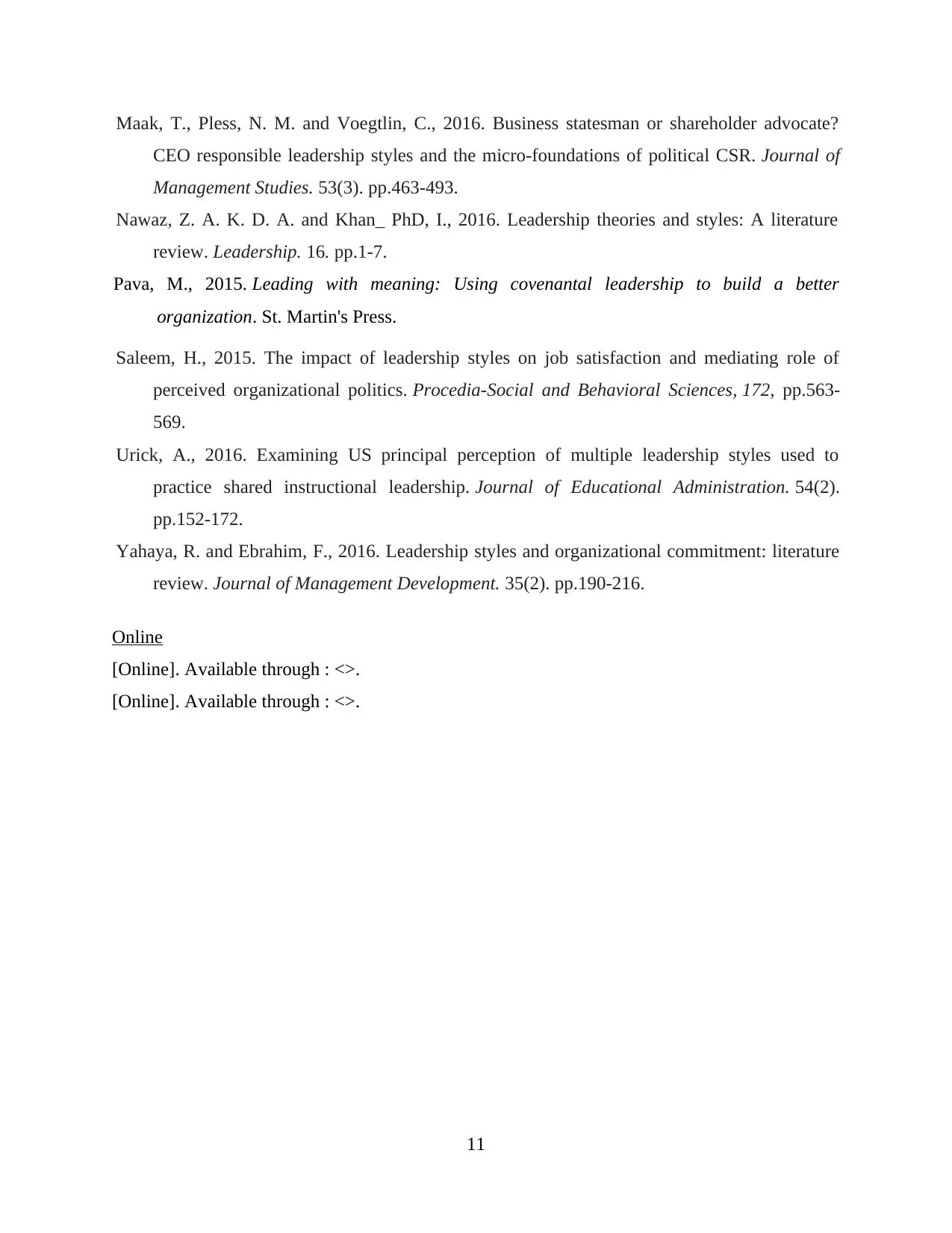
Maak, T., Pless, N. M. and Voegtlin, C., 2016. Business statesman or shareholder advocate?
CEO responsible leadership styles and the micro‐foundations of political CSR. Journal of
Management Studies. 53(3). pp.463-493.
Nawaz, Z. A. K. D. A. and Khan_ PhD, I., 2016. Leadership theories and styles: A literature
review. Leadership. 16. pp.1-7.
Pava, M., 2015. Leading with meaning: Using covenantal leadership to build a better
organization. St. Martin's Press.
Saleem, H., 2015. The impact of leadership styles on job satisfaction and mediating role of
perceived organizational politics. Procedia-Social and Behavioral Sciences, 172, pp.563-
569.
Urick, A., 2016. Examining US principal perception of multiple leadership styles used to
practice shared instructional leadership. Journal of Educational Administration. 54(2).
pp.152-172.
Yahaya, R. and Ebrahim, F., 2016. Leadership styles and organizational commitment: literature
review. Journal of Management Development. 35(2). pp.190-216.
Online
[Online]. Available through : <>.
[Online]. Available through : <>.
11
CEO responsible leadership styles and the micro‐foundations of political CSR. Journal of
Management Studies. 53(3). pp.463-493.
Nawaz, Z. A. K. D. A. and Khan_ PhD, I., 2016. Leadership theories and styles: A literature
review. Leadership. 16. pp.1-7.
Pava, M., 2015. Leading with meaning: Using covenantal leadership to build a better
organization. St. Martin's Press.
Saleem, H., 2015. The impact of leadership styles on job satisfaction and mediating role of
perceived organizational politics. Procedia-Social and Behavioral Sciences, 172, pp.563-
569.
Urick, A., 2016. Examining US principal perception of multiple leadership styles used to
practice shared instructional leadership. Journal of Educational Administration. 54(2).
pp.152-172.
Yahaya, R. and Ebrahim, F., 2016. Leadership styles and organizational commitment: literature
review. Journal of Management Development. 35(2). pp.190-216.
Online
[Online]. Available through : <>.
[Online]. Available through : <>.
11
1 out of 13
Related Documents
Your All-in-One AI-Powered Toolkit for Academic Success.
+13062052269
info@desklib.com
Available 24*7 on WhatsApp / Email
![[object Object]](/_next/static/media/star-bottom.7253800d.svg)
Unlock your academic potential
© 2024 | Zucol Services PVT LTD | All rights reserved.





